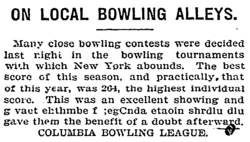Etaoin shrdlu


Etaoin shrdlu (/ˈɛtiˌɔɪnˈʃɜːrdluː/)[1] is a nonsense phrase that sometimes appeared in print in the days of "hot type" publishing because of a custom of type-casting machine operators. It appeared often enough to become part of newspaper lore, and "etaoin shrdlu" is listed in the Oxford English Dictionary and in the Random House Webster's Unabridged Dictionary.
It is the approximate order of frequency of the 12 most commonly used letters in the English language.[2]
History
The letters on type-casting machine keyboards (such as Linotype and Intertype) were arranged by letter frequency, so e-t-a-o-i-n s-h-r-d-l-u were the lowercase keys in the first two vertical columns on the left side of the keyboard. When operators made a mistake in composing, they would often finish the line by running a finger down the first two columns of the keyboard and then start over. Occasionally the faulty line of hot-metal type would be overlooked and printed erroneously.
A documentary about the last issue of The New York Times to be composed in the hot-metal printing process (2 July 1978) was titled Farewell, Etaoin Shrdlu.[3]
In 1966, Irving Fang analyzed a collection of newspaper text and television news copy, and produced the ordering "ETAONIRSHDLC".[4] Peter Norvig processed the Google Books Ngrams in 2013 and found its ordering was "ETAOINSRHLDCU".[5]
Appearance outside typography

The phrase has gained enough notability to appear outside typography, including:
Computing
- SHRDLU was used in 1972 by Terry Winograd as the name for an early artificial-intelligence system in Lisp.[6]
- The ETAOIN SHRDLU Chess Program was written by Garth Courtois Jr. for the Nova 1200 mini-computer, competing in the 6th and 7th ACM North American Computer Chess Championship 1975 and 1976.[7]
- "Etienne Shrdlu" was used as the name of a character in Mavis Beacon Teaches Typing, touch-typing training software from the late 1980s.[8]
- ETA Systems chief architect Neil Lincoln maintained that the name of the firm derived from the first three letters of a Linotype keyboard.
Literature
- Elmer Rice's 1923 play The Adding Machine includes Shrdlu as a character.[9]
- In 1942 Etaoin Shrdlu was the title of a short story by Fredric Brown about a sentient Linotype machine. (A sequel, Son of Etaoin Shrdlu: More Adventures in Typer and Space, was written by others in 1981.)[9]
- Anthony Armstrong's 1945 whimsical short story "Etaoin and Shrdlu" ends "And Sir Etaoin and Shrdlu married and lived so happily ever after that whenever you come across Etaoin's name even today it's generally followed by Shrdlu's".[9]
- It is the name of a science fiction fanzine edited by Sheldon Lee Glashow & Steven Weinberg[10]
- Mr. Etaoin is a character – the Abalone newspaper typesetter – in The Circus of Dr. Lao.[11]
- "Mr. Shrdlu -- Etaoin Shrdlu" is Houn' Dog's response to Pogo's question, "What you say his name is, Houn' Dog?" referencing the author of Webster's Dictionary in the daily strip for March 11, 1950, by Walt Kelly (reproduced on page 51 of the first paperback collection of Pogo cartoons, Pogo).
- Thomas Pynchon named a character "Etienne Cherdlu" in his early short story The Secret Integration (1962) (see Slow Learner (1984)).
- Three pieces in The New Yorker magazine were published in 1925, under the pen name Etain Shrdlu.[12]
- At least one piece in The New Yorker magazine has Etaoin Shrdlu in the title.[13]
- Edwin Morgan's poem "A View of Things", published in his collection The Second Life (1968), contains the line "what I love about newspapers is their etaoin shrdl".[14]
- H. Beam Piper used "etaoin shrdlu" as part of someone swearing in his book Four Day Planet.[15]
- Max Shulman used the term as a name of several once-referenced characters in the 1944 book Barefoot Boy with Cheek
Media
- In 1958, the National Press Club (USA) published Shrdlu - An Affectionate Chronicle, a 50-year retrospective of the Club's history.[16]
- Etaoin Shrdlu is the name of a character in at least two Robert Crumb comic stories. The Complete Crumb Comics Vol. 14
- Etaoin and Shrdlu both appear frequently in the drawings of Emile Mercier, as place names, racehorses' names and people's names.
- "Farewell, Etaoin Shrdlu," filmed on July 1, 1978, is a documentary by David Loeb Weiss that chronicles the end of "hot type" and the introduction of computers into The New York Times’s printing process. THE NEW YORK TIMES | Oct. 13, 2016
Music
- Shrdlu (Norman Shrdlu) is listed as the composer of "Jam Blues", cut 1 on the 1951 Norman Granz produced Jazz album released in 1990 as "Charlie Parker Jam Session". This appears to be a joke on Parker's part as Norman Shrdlu is credited in several Parker (and other) tunes.
- "Etaoin Shrdlu" is the title of the first song on Cul de Sac's 1999 album Crashes to Light, Minutes to Its Fall.
See also
References
- ↑ "etaoin shrdlu". Merriam-Webster. Encyclopædia Britannica.
- ↑ Stoddard, Samuel (2004). "Letter Frequency". Fun With Words. RinkWorks. Retrieved 28 June 2013.
- ↑ Farewell, Etaoin Shrdlu (Motion picture). New York City: Educational Media Collection/University of Washington. Retrieved 28 June 2013.
- ↑ Irving E. Fang, "It Isn't ETAOIN SHRDLU; It's ETAONI RSHDLC," Journalism Quarterly, December 1966, vol. 43, no. 4, pages 761-762
- ↑ "English Letter Frequency Counts: Mayzner Revisited or ETAOIN SRHLDCU". Retrieved 24 April 2016.
- ↑ Winograd, Terry. "How SHRDLU got its name". SHRDLU. Stanford University. Retrieved 28 June 2013.
- ↑ Courtois Jr., Garth (7 August 2008). "Am I old enough to remember keypunch cards? Umm, yeah...". Blog Archives. ababsurdo.com. Retrieved 27 June 2013.
- ↑ Weasel, Yah. "Let's Play Mavis Beacon Teaches Typing". YouTube. Retrieved 26 August 2015.
- 1 2 3 Quinion, Michael. "etaoin shrdlu". Weird Words. World Wide Words. Retrieved 28 June 2013.
- ↑ Carter Scholz, Gregory Benford, Hugh Gusterson, Sam Cohen, Curtis LeMay. "Radiance". Retrieved 24 April 2016.
- ↑ Charles G. Finney (1935), The Circus of Dr. Lao, Viking Press, ISBN 4-87187-664-0
- ↑ "Etain Shrdlu - The New Yorker". The New Yorker. 28 March 1925. Retrieved 24 April 2016.
- ↑ Charles Cooke (31 October 1936). "It Can't Etaoin Shrdlu.". The New Yorker. Retrieved 24 April 2016.
- ↑ "A View of Things". The Edwin Morgan Archive at the Scottish Poetry Library. Retrieved 19 May 2016.
- ↑ Four-Day Planet by H. Beam Piper.
- ↑ Shrdlu - An Affectionate Chronicle. Washington, DC: National Press Club. 1958.
External links
- Farewell, Etaoin Shrdlu at the Internet Movie Database
- "What's the origin of the mysterious phrase etaoin shrdlu?" at The Straight Dope
- Excerpt demonstrating etaoin shrdlu from the film Linotype: The Film at the Internet Movie Database
- Over 100 examples of the phrase used in American newspapers from 1836–1922 at the Library of Congress
- English Letter Frequency Counts: Mayzner Revisited or ETAOIN SRHLDCU